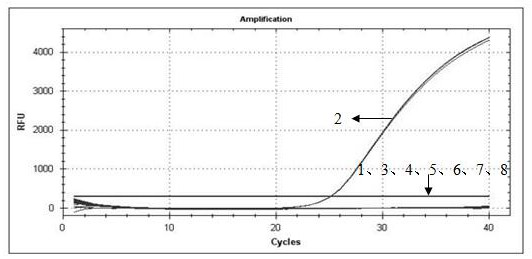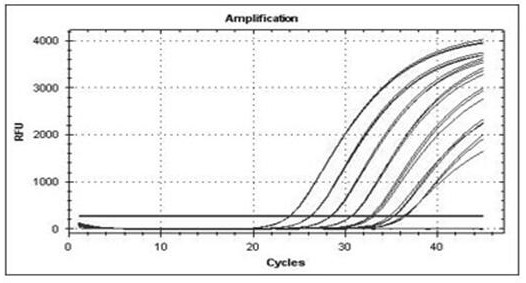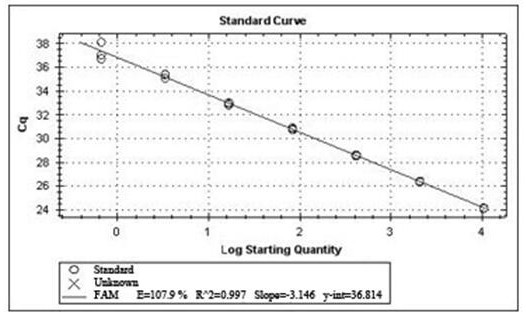Method for detecting content of herbicide-resistant transgenic soybean J12 through real-time fluorescent quantitative PCR
A technology for quantitative detection of genetically modified soybeans, which can be used in the determination/inspection of microorganisms, biochemical equipment and methods, DNA/RNA fragments, etc., which can solve the problems of genetically modified soybean J12 qualitative and quantitative, and the lack of genetically modified soybean J12 methods.
- Summary
- Abstract
- Description
- Claims
- Application Information
AI Technical Summary
Problems solved by technology
Method used
Image
Examples
Embodiment 1
[0039] (1) Sample 1: A self-made simulated mixed sample of 5% genetically modified herbicide-tolerant soybean J12. The mixing method was to thoroughly mix 500 ng of genetically modified herbicide-tolerant soybean J12 genomic DNA and 9500 ng of non-transgenic soybean WT genomic DNA.
[0040] (2) Reagents: Premix Ex Taq (Probe qPCR) master mix produced by TaKaRa Company; soybean endogenous Lectin gene and transformant-specific sequence amplification primers synthesized by Shanghai Sangon.
[0041] Transformant-specific sequence primers:
[0042] Forward primer sequence: 5'- GGCTTTACTAAAATATAAATCCTAA -3'
[0043] Reverse primer sequence: 5'- GGCGTTAATTCAGTACATTA -3'
[0044] Probe sequence: FAM-TGACGCTTAGACAACTTAATAACACAT-BHQ1
[0045] endogenous gene Lectin gene sequence:
[0046] Forward primer sequence: 5'-GCCCTCTACTCCACCCCCCA-3'
[0047] Reverse primer sequence: 5'-GCCCATCTGCAAGCCTTTTT-3'
[0048] Probe sequence: FAM-AGCTTCGCCGCTTCCTTCAACTTCAC-BHQ1;
[0049] (3) PCR r...
Embodiment 2
[0064] (1) Sample 2: GM herbicide-tolerant soybean J12 was a self-made simulated mixed sample with 3% ingredients, and the mixing method was 300 ng of genetically modified herbicide-tolerant soybean J12 genomic DNA and 9700 ng of non-transgenic soybean WT genomic DNA were thoroughly mixed.
[0065] (2) Reagents: Premix Ex Taq (Probe qPCR) master mix produced by TaKaRa Company; soybean endogenous Lectin gene and transformant-specific sequence amplification primers synthesized by Shanghai Sangon.
[0066] Transformant-specific sequence primers:
[0067] Forward primer sequence: 5'- GGCTTTACTAAAATATAAATCCTAA -3'
[0068] Reverse primer sequence: 5'- GGCGTTAATTCAGTACATTA -3'
[0069] Probe sequence: FAM-TGACGCTTAGACAACTTAATAACACAT-BHQ1
[0070] endogenous gene Lectin gene sequence:
[0071] Forward primer sequence: 5'-GCCCTCTACTCCACCCCCCA-3'
[0072] Reverse primer sequence: 5'-GCCCATCTGCAAGCCTTTTT-3'
[0073] Probe sequence: FAM-AGCTTCGCCGCTTCCTTCAACTTCAC-BHQ1;
[0074] (...
PUM
 Login to View More
Login to View More Abstract
Description
Claims
Application Information
 Login to View More
Login to View More - R&D
- Intellectual Property
- Life Sciences
- Materials
- Tech Scout
- Unparalleled Data Quality
- Higher Quality Content
- 60% Fewer Hallucinations
Browse by: Latest US Patents, China's latest patents, Technical Efficacy Thesaurus, Application Domain, Technology Topic, Popular Technical Reports.
© 2025 PatSnap. All rights reserved.Legal|Privacy policy|Modern Slavery Act Transparency Statement|Sitemap|About US| Contact US: help@patsnap.com



